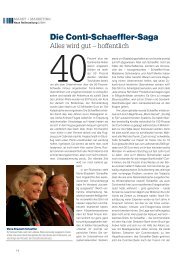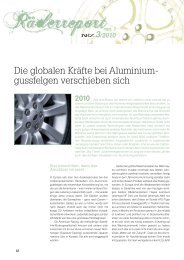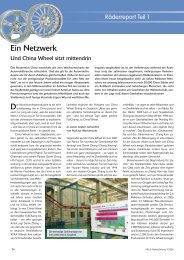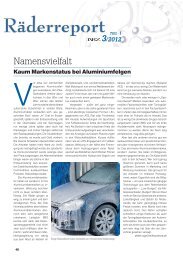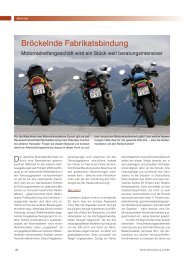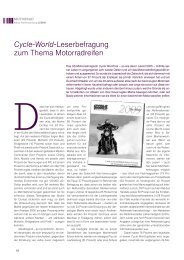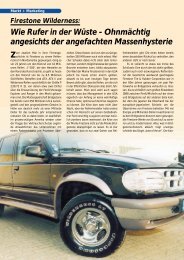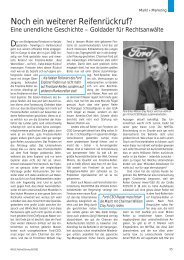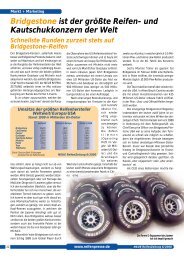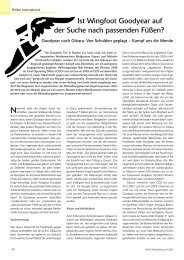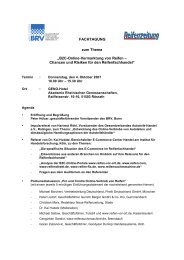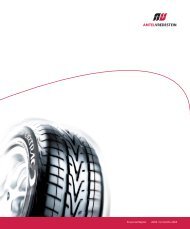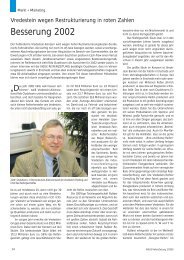Layout 1 (Page 1) - Reifenpresse.de
Layout 1 (Page 1) - Reifenpresse.de
Layout 1 (Page 1) - Reifenpresse.de
Erfolgreiche ePaper selbst erstellen
Machen Sie aus Ihren PDF Publikationen ein blätterbares Flipbook mit unserer einzigartigen Google optimierten e-Paper Software.
Retrea<strong>de</strong>rs in Europe<br />
un<strong>de</strong>r regulatory influence<br />
Guest Comment by<br />
BIPAVER’s adviser<br />
In the wake of regulatory initiatives Europe’s retreading<br />
industry is facing far reaching changes. Michael<br />
Schwämmlein, who is responsible for Kraiburg Austria-<br />
’s technical service, plant engineering and product assortment<br />
policy, and who at the same time is technical<br />
adviser to the BIPAVER and <strong>de</strong>legate to the GRRF in Geneva,<br />
summarises the state of affairs and points out<br />
possible options:<br />
For years the European retreading industry has attempted to establish<br />
a unitary standard allowing for the same quality levels<br />
provi<strong>de</strong>d by new tyres. After some countries set out their own<br />
national standards, or rather opted for the integration of ECE-R<br />
108/109 into national law, these regulations have been mandatory<br />
since September 13, 2006. Implementing these regulations has been<br />
quite complicated because, in contrast to the type approval process<br />
for new tyres – for which a hundred thousand i<strong>de</strong>ntical copies may<br />
be produced – a procedure had to be found that allowed for the certification<br />
of an entire retreading plant.<br />
Without a doubt the introduction of ECE-R 108/109 has contributed<br />
to the consolidation of the retreading market and to the reputation<br />
of retreads in general. However, as in many techical fields, requirements<br />
are never static, and because the ecological and economic<br />
aspects of road transportation have increasingly been forced into<br />
the spotlight, the requirements for tyres have also increased. Some<br />
time ago ago the EU directorate-generals in Brussels and national<br />
legislatory bodies voiced their <strong>de</strong>mands that a vehicle’s tyre equipment<br />
should be analysed and then optimised as part of a functional<br />
chain that inclu<strong>de</strong>s “road noise” (rolling sound emissions), “fuel consumption”<br />
(rolling resistance coefficient) and safety-related aspects<br />
(wet grip, suitable for winter conditions, etc). The catalogue of<br />
requirements for rolling sound emissions have now passed the legislatory<br />
bodies, and these noise regulations specifying permissible<br />
sound emission limits (ECE-R 117) will come into effect for the European<br />
replacement markets in 2009. Then motorists will only be allowed<br />
to mount tyres that have passed a noise-test and received a<br />
“Sound” mark. Currently the subject of the rolling resistance coefficient<br />
and thus the reduction of fuel consumption and emissions has<br />
ma<strong>de</strong> its way to the top of the agenda in Brussels and in the technical<br />
committees in Geneva.<br />
But what do lawmakers and technical committees exactly mean<br />
when they talk about “tyres”? Every kind of tyre that can be found<br />
rolling on our roads? Unfortunately not, because these institutions<br />
say “tyres” but are solely referring to type approved new tyres, the<br />
30<br />
Run<strong>de</strong>rneuerer unter<br />
<strong>de</strong>m Einfluss <strong>de</strong>r Gesetze<br />
Gast-Kommentar von<br />
BIPAVER-Berater<br />
Die Run<strong>de</strong>rneuerungsbranche steht vor weit reichen<strong>de</strong>n<br />
Neuerungen im Zuge geplanter Gesetzesän<strong>de</strong>rungen.<br />
Michael Schwämmlein – Leiter Technischer Service,<br />
Anlagenbau und Sortimentspolitik bei Kraiburg<br />
Austria und Technischer Berater <strong>de</strong>s BIPAVER und<br />
Vertreter in <strong>de</strong>r GRRF in Genf (Arbeitsgruppe<br />
Bremsen/Fahrwerk) – fasst <strong>de</strong>n Stand <strong>de</strong>r Dinge<br />
zusammen und skizziert mögliche Optionen:<br />
Seit Jahren versucht die Run<strong>de</strong>rneuerungsbranche in Europa<br />
durch Einführung eines einheitlichen Standards <strong>de</strong>n Anschluss<br />
an die Qualität <strong>de</strong>s Neureifens zu halten. Obwohl einige<br />
Län<strong>de</strong>r dafür schon seit einiger Zeit nationale Standards <strong>de</strong>finiert<br />
bzw. die ECE-R 108/109 freiwillig national umgesetzt haben, ist<br />
diese nun seit 13. September 2006 obligatorisch. Die Umsetzung war<br />
eine schwere Geburt, <strong>de</strong>nn an<strong>de</strong>rs als bei <strong>de</strong>r „Typprüfung“ eines<br />
Neureifens, <strong>de</strong>r hun<strong>de</strong>rttausendfach i<strong>de</strong>ntisch reproduziert wird,<br />
musste für die Run<strong>de</strong>rneuerung ein Proce<strong>de</strong>re für die Zertifizierung<br />
einer kompletten Betriebsstätte gefun<strong>de</strong>n wer<strong>de</strong>n. Die Einführung<br />
<strong>de</strong>r ECE-R 108/109 hat sicher dazu beigetragen, <strong>de</strong>n Run<strong>de</strong>rneuerungsmarkt<br />
zu konsolidieren und das „Ansehen“ <strong>de</strong>s run<strong>de</strong>rneuerten<br />
Reifens zu verbessern. Aber, wie in vielen technischen Bereichen,<br />
sind Anfor<strong>de</strong>rungen nie statisch und im Zuge <strong>de</strong>r immer mehr<br />
in <strong>de</strong>n Mittelpunkt rücken<strong>de</strong>n ökologischen und ökonomischen Aspekte<br />
im Straßenverkehr steigt <strong>de</strong>r Anfor<strong>de</strong>rungsdruck auf <strong>de</strong>n Reifen<br />
weiter. Längst sind in <strong>de</strong>n Generaldirektionen <strong>de</strong>r EU in Brüssel<br />
und <strong>de</strong>n gesetzgeben<strong>de</strong>n nationalen Institutionen For<strong>de</strong>rungen laut<br />
gewor<strong>de</strong>n, die Fahrzeugbereifung in <strong>de</strong>r Wirkungskette für Straßenlärm<br />
(Reifen-Fahrbahn-Geräusch), Treibstoffverbrauch (Rollwi<strong>de</strong>rstandsbeiwert)<br />
sowie sicherheitstechnischen Aspekten (Nässehaftung,<br />
Wintertauglichkeit etc.) zu analysieren und zu optimieren. Der<br />
Anfor<strong>de</strong>rungskatalog für das Reifen-Fahrbahn-Geräusch, also die<br />
zulässigen Grenzwerte und die ECE-R 117, sind verabschie<strong>de</strong>t und<br />
wer<strong>de</strong>n bis 2009 auch für alle Reifen im Ersatzgeschäft greifen. Dann<br />
dürfen nur noch Reifen mit einer so genannten „Sound“-Kennzeichnung<br />
montiert wer<strong>de</strong>n. Derzeit stehen das Thema Rollwi<strong>de</strong>rstandsbeiwert<br />
und somit Treibstoffverbrauchs- und Emissionsreduzierung<br />
in Brüssel und <strong>de</strong>n Fachausschüssen in Genf ganz oben auf <strong>de</strong>r Prioritätenliste.<br />
Was meinen Gesetzgeber und Fachausschüsse aber, wenn sie<br />
von „Reifen“ sprechen? Alle Reifenarten, die sich auf unseren Straßen<br />
tummeln? Lei<strong>de</strong>r nein, <strong>de</strong>nn in <strong>de</strong>ren Verständnis ist „<strong>de</strong>r Reifen“<br />
immer nur das typgeprüfte Neuprodukt, das zigtausendfach aus<br />
<strong>de</strong>r Fabrik rollt und <strong>de</strong>shalb im Bereich technischer Eigenschaften



